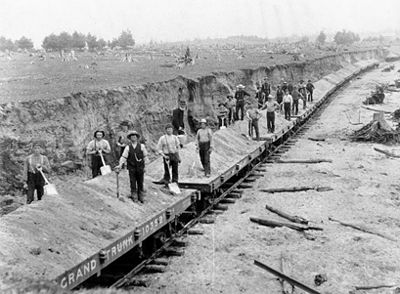Asbestos is a mineral. It has many uses. For instance, it can be used for insulation, furnaces and brake pads. Quebec produced the most asbestos in the world by 1949, 85 per cent. In February 1949, thousands of miners in a town called Asbestos as well as Thetford Mines went on strike (see Val-des-Sources (Asbestos)). The government in Quebec was against the workers. It sided with the main employer, the American-owned Johns-Manville Company. The Catholic Church was for the workers (see Catholicism in Canada). This made the government and the Church clash. The strike is famous for two main reasons. First, it was violent. Second, it contributed to the creation of the Quiet Revolution in the 1960s. The Quiet Revolution was a time when francophones assumed more leadership positions in Quebec.
This article is a plain-language summary of the Asbestos Strike of 1949. If you are interested in reading about this topic in more depth, please see our full-length entry, Asbestos Strike of 1949.
Background
By the late 1940s asbestos miners in Quebec were not content. They believed they should receive more money. They also wanted to have better working conditions. Asbestos miners often got sick. Breathing in asbestos causes lung disease and different types of cancers.
The Strike
On 14 February 1949, 5,000 workers in four mines in Asbestos and Thetford Mines went on strike (see Val-des-Sources (Asbestos)). They wanted pay of $1 per hour, nine paid holidays, a pension, a plan to limit the amount of asbestos dust and more union control of the mines. A union is an organization that tries to help workers. The union that helped the workers in the strike was linked to the Catholic Church (see Catholicism in Canada). Its name was the Canadian Catholic Confederation of Labour. (See also Confederation of National Trade Unions.)
The premier of Quebec, Maurice Duplessis, was against the workers. He supported the company that owned the asbestos mines. He was also against strikes. He and his government made the strike illegal. He then sent the provincial police to Asbestos. Joseph Charbonneau, on the other hand, sided with the strikers. Charbonneau was the archbishop of Montreal. He had much power and authority. The Asbestos Strike was the first time the Church sided with strikers. Charbonneau asked all priests to support the workers. He also asked them to collect money from their parishioners to help the strikers. Maurice Duplessis was very angry at Archbishop Charbonneau. Duplessis also had power and authority. He appears to have convinced the Catholic Church in Quebec to make Charbonneau resign. Charbonneau was then moved to British Columbia.
The strike quickly turned violent. It started when new workers came to work in the mines. The new workers were hired by Johns-Manville Company that owned the mines. The strikers tried to stop the new workers from entering the mines. Following this, someone set off an explosion on a railroad line and a company official was beaten. The company then asked the courts to make it illegal to stop the workers from picketing. A picket is an event in which individuals (workers) form a line of sorts and carry signs about their cause. The courts agreed with the company. To make sure that the workers would stop picketing the police got involved. They used tear gas and shot their guns in the sky. On 5 May, strikers beat up policemen (who were not dressed like policemen). The next day 400 police officers went to Asbestos and broke up the strike. Using violence and tear gas, the police arrested 180 miners. The events at Asbestos became famous as journalists witnessed the story and then wrote about it.
Results
The strike ended on 1 July 1949. The miners eventually got paid more. Some miners lost their jobs, though. The strike helped to break the power that Maurice Duplessis had. It ultimately signaled a very big change in Quebec. More and more francophones came to believe that it was important for them to gain control of the government so that they could make a Quebec that would serve them, not non-Francophone companies or the anglophone elite. (See also Quiet Revolution.)

 Share on Facebook
Share on Facebook Share on X
Share on X Share by Email
Share by Email Share on Google Classroom
Share on Google Classroom











